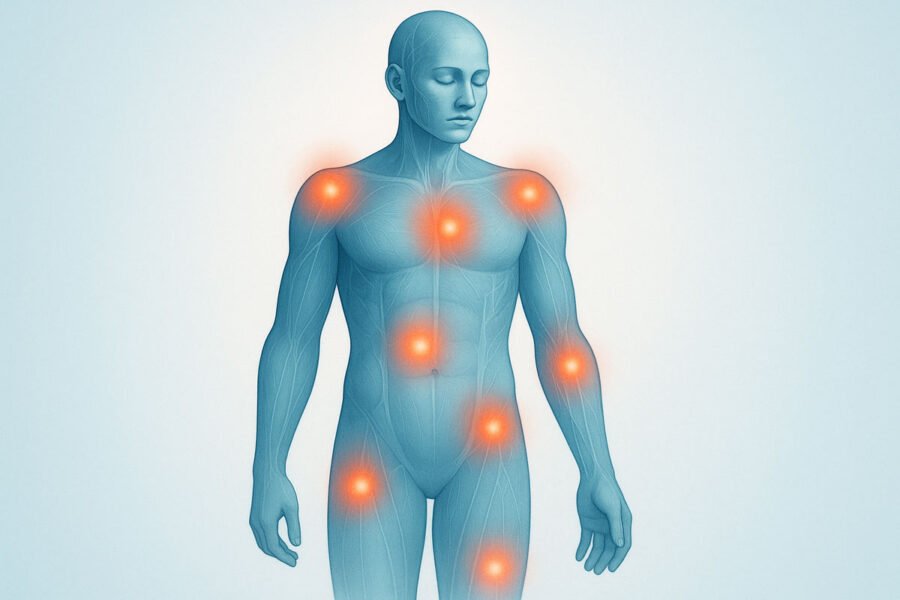Skip to the good bit
ToggleWhat is Fibromyalgia?
Fibromyalgia is a persistent condition that brings widespread pain to the entire body. As a chronic illness, it targets the muscles and soft tissues, resulting in ongoing discomfort and a variety of other challenging symptoms.
This condition can deeply affect a person’s daily life, turning simple activities into difficult tasks. While a cure for fibromyalgia has not yet been found, a combination of effective treatments and lifestyle changes can help individuals manage their symptoms and regain control.
The Telltale Signs: Recognizing Fibromyalgia Symptoms
Widespread and Persistent Pain
The most defining symptom of fibromyalgia is a constant, dull ache that spreads across both sides of the body, from head to toe. This pain is often felt as a deep, muscular soreness that can fluctuate in intensity from day to day.
People with fibromyalgia often find they are more sensitive to pain, where a simple touch might feel painful. This pain is frequently accompanied by stiffness, which can be most pronounced in the morning or after being still for a while.
More Than Just Tiredness: Debilitating Fatigue
Another key feature of fibromyalgia is a profound sense of fatigue that sleep doesn’t seem to fix. This level of exhaustion can be all-consuming, making it a struggle to keep up with work, social life, and personal responsibilities.
It’s common for those with fibromyalgia to wake up feeling as though they haven’t slept at all. This persistent tiredness is often connected to other sleep issues, like restless legs syndrome or sleep apnea, which frequently coexist with the condition.
The Cognitive Impact: Understanding “Fibro Fog”
“Fibro fog” is the term many use to describe the cognitive struggles that come with fibromyalgia. This can include trouble with memory, a short attention span, and a general lack of mental clarity, making it hard to stay focused or learn new things.
This mental cloudiness can be incredibly frustrating and adds another layer to the challenges of the condition. It’s thought to stem from how the brain is forced to process a constant stream of pain signals and other sensory information.
Unraveling the Mystery: What Causes Fibromyalgia?
The precise cause of fibromyalgia is still a puzzle, but experts believe it’s likely a mix of different factors. There seems to be a genetic link, as the condition often appears in multiple members of the same family.
In some individuals, an infection, a physical injury, or a period of intense emotional stress appears to act as a trigger for the onset of fibromyalgia. Researchers also point to irregular levels of certain brain chemicals and shifts in how the central nervous system interprets pain signals as contributing factors.
The Path to Diagnosis
Getting a fibromyalgia diagnosis can be a lengthy journey. There isn’t a straightforward test for it. Instead, doctors must conduct a careful physical exam, go over a patient’s full medical history, and rule out other conditions that might cause similar symptoms.
A diagnosis is generally confirmed when a person has experienced widespread pain for at least three months, alongside other core symptoms like fatigue and cognitive issues. Your physician may also order blood tests to ensure no other underlying conditions are causing the symptoms.
A Multifaceted Approach to Managing Fibromyalgia
Medical Treatments
While fibromyalgia has no cure, various medications can provide significant symptom relief. Pain medications, including both over-the-counter options and prescriptions, can help lessen the discomfort. Antidepressants are also frequently used to help manage both pain and fatigue.
The Role of Therapy
Therapy is a vital component of a comprehensive fibromyalgia management plan. A physical therapist can guide you through exercises to build strength and improve flexibility, while an occupational therapist can help you discover new, less strenuous ways to handle daily activities.
Counseling, particularly cognitive behavioral therapy (CBT), has proven to be very helpful. It equips individuals with effective coping strategies to manage not just the pain, but also the emotional toll that comes with living with a chronic illness.
Lifestyle Adjustments for a Better Quality of Life
Adopting certain lifestyle habits is fundamental to managing fibromyalgia. Engaging in regular, low-impact exercise like walking, swimming, or yoga can significantly reduce pain and promote better sleep. Creating a consistent and restful sleep routine is also key to fighting off fatigue.
Learning stress-reduction techniques such as meditation, deep breathing, and mindfulness can lower the frequency and severity of symptom flare-ups. Maintaining a balanced diet and learning to pace your activities throughout the day are also crucial for preserving energy.
Living and Thriving with Fibromyalgia
Living with fibromyalgia means taking a proactive and well-rounded approach to your health. By partnering with your healthcare providers and embracing a mix of treatments and lifestyle adjustments, you can effectively manage your symptoms and enjoy a full, active life.
Don’t underestimate the power of a strong support network. Leaning on family, friends, and connecting with others who understand the fibromyalgia journey can provide invaluable emotional comfort and encouragement. With the right tools and support, you can learn to not just live, but thrive, in the face of this chronic condition.







